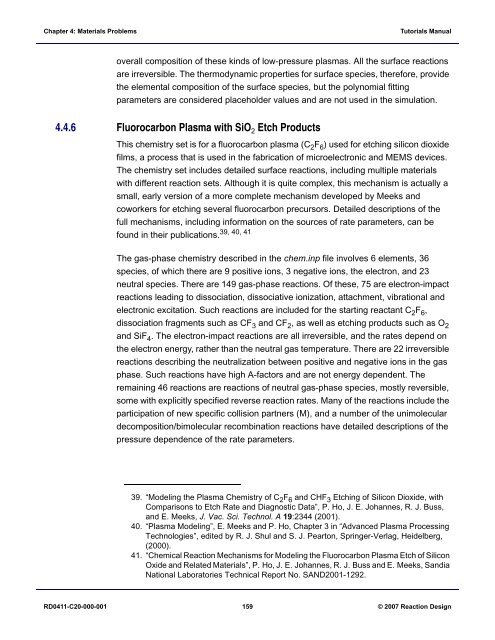Tutorials Manual
Tutorials Manual
Tutorials Manual
You also want an ePaper? Increase the reach of your titles
YUMPU automatically turns print PDFs into web optimized ePapers that Google loves.
Chapter 4: Materials Problems<br />
<strong>Tutorials</strong> <strong>Manual</strong><br />
overall composition of these kinds of low-pressure plasmas. All the surface reactions<br />
are irreversible. The thermodynamic properties for surface species, therefore, provide<br />
the elemental composition of the surface species, but the polynomial fitting<br />
parameters are considered placeholder values and are not used in the simulation.<br />
4.4.6 Fluorocarbon Plasma with SiO 2 Etch Products<br />
This chemistry set is for a fluorocarbon plasma (C 2 F 6 ) used for etching silicon dioxide<br />
films, a process that is used in the fabrication of microelectronic and MEMS devices.<br />
The chemistry set includes detailed surface reactions, including multiple materials<br />
with different reaction sets. Although it is quite complex, this mechanism is actually a<br />
small, early version of a more complete mechanism developed by Meeks and<br />
coworkers for etching several fluorocarbon precursors. Detailed descriptions of the<br />
full mechanisms, including information on the sources of rate parameters, can be<br />
39, 40, 41<br />
found in their publications.<br />
The gas-phase chemistry described in the chem.inp file involves 6 elements, 36<br />
species, of which there are 9 positive ions, 3 negative ions, the electron, and 23<br />
neutral species. There are 149 gas-phase reactions. Of these, 75 are electron-impact<br />
reactions leading to dissociation, dissociative ionization, attachment, vibrational and<br />
electronic excitation. Such reactions are included for the starting reactant C 2 F 6 ,<br />
dissociation fragments such as CF 3 and CF 2 , as well as etching products such as O 2<br />
and SiF 4 . The electron-impact reactions are all irreversible, and the rates depend on<br />
the electron energy, rather than the neutral gas temperature. There are 22 irreversible<br />
reactions describing the neutralization between positive and negative ions in the gas<br />
phase. Such reactions have high A-factors and are not energy dependent. The<br />
remaining 46 reactions are reactions of neutral gas-phase species, mostly reversible,<br />
some with explicitly specified reverse reaction rates. Many of the reactions include the<br />
participation of new specific collision partners (M), and a number of the unimolecular<br />
decomposition/bimolecular recombination reactions have detailed descriptions of the<br />
pressure dependence of the rate parameters.<br />
39. “Modeling the Plasma Chemistry of C 2 F 6 and CHF 3 Etching of Silicon Dioxide, with<br />
Comparisons to Etch Rate and Diagnostic Data”, P. Ho, J. E. Johannes, R. J. Buss,<br />
and E. Meeks, J. Vac. Sci. Technol. A 19:2344 (2001).<br />
40. “Plasma Modeling”, E. Meeks and P. Ho, Chapter 3 in “Advanced Plasma Processing<br />
Technologies”, edited by R. J. Shul and S. J. Pearton, Springer-Verlag, Heidelberg,<br />
(2000).<br />
41. “Chemical Reaction Mechanisms for Modeling the Fluorocarbon Plasma Etch of Silicon<br />
Oxide and Related Materials”, P. Ho, J. E. Johannes, R. J. Buss and E. Meeks, Sandia<br />
National Laboratories Technical Report No. SAND2001-1292.<br />
RD0411-C20-000-001 159 © 2007 Reaction Design
















